An investigative walk-through of Go's channels
This is a summary of a talk I gave during Gophercon Vietnam & Gophercon India. If you have seen this talk already, you might find the concepts crystallized after reading the blog post. You can find the slides here.
I have split this blog post, similar to the way I had structured the talk:
- A simple scraper walk-through
- Deep dive into Go's channels
- Runtime execution and demo
#Simple scraper walk-through
In this walk-through, I will be talking about a simple program to scrape from Amazon's product listing page. All the code is available here.
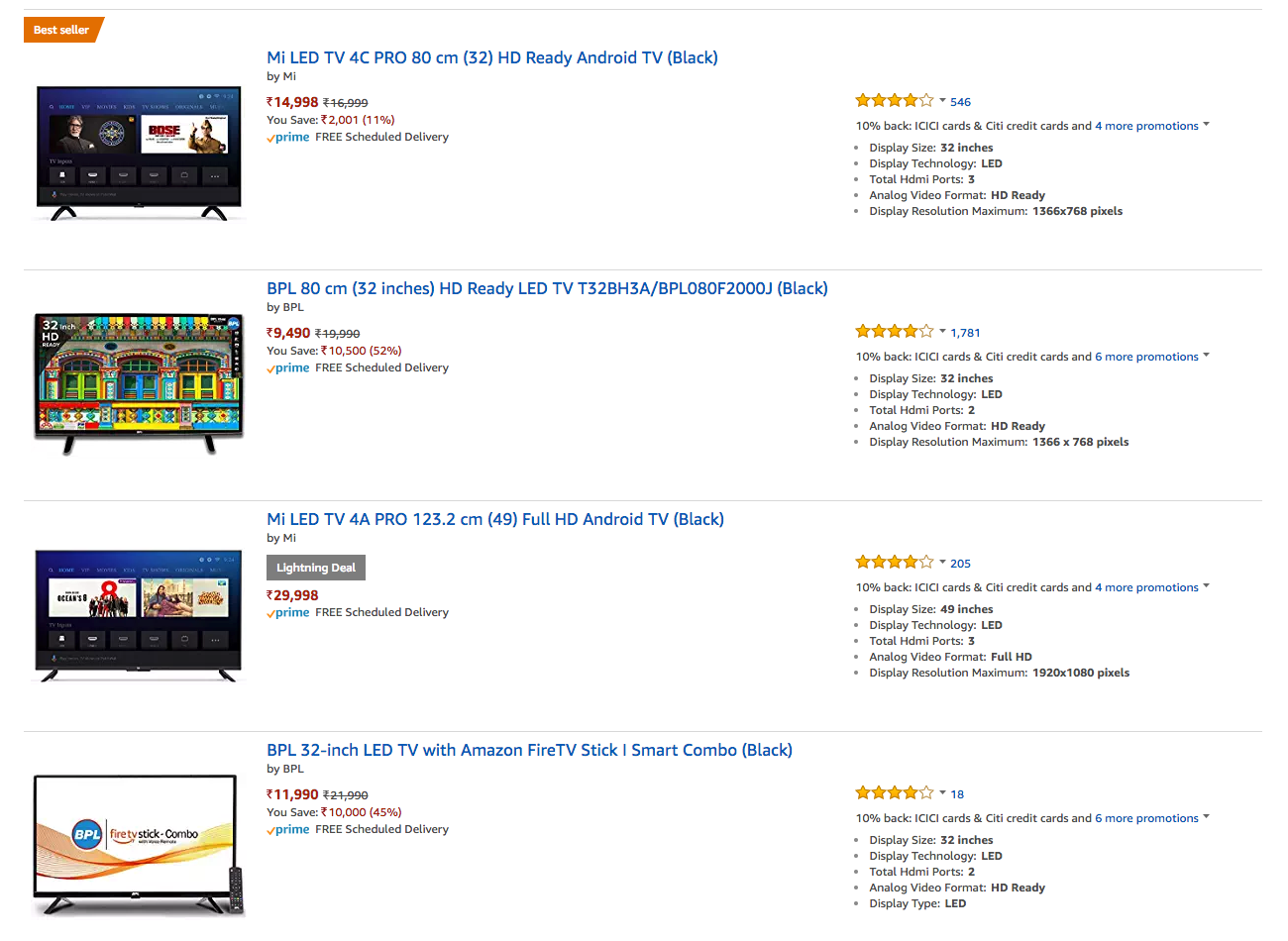
Here, we are scraping data into a struct which looks like:
type Product struct {
Name string
Link string
Image string
Price string
Reviews []Review
}In this program, I am using a simple scraping & parsing library called soup.
The algorithm can be summarized as:
-
Open up the product listing page
-
Parse the products
- For each product, get it's name, image, price and link.
- Visit the product's page using the scraped
link
-
-
In the product's page,
-
Parse the reviews
- For each review, get it's name, rating and content
-
As a result, the snippet of code below,

produces the following output:
{
"Name": "Sanyo 108.2 cm (43 inches) Full HD IPS LED TV XT-43S7100F (Black)",
"Link": "https://www.amazon.in/Sanyo-108-2-inches-XT-43S7100F-Black/dp/B01ICVLK4S/ref=lp_1389396031_1_5/260-5276449-2035623?s=electronics&ie=UTF8&qid=1540385124&sr=1-5",
"Image": "https://images-eu.ssl-images-amazon.com/images/I/51F0yKjVX1L._AC_US218_.jpg",
"Price": "17,990",
"Reviews": [
{
"Name": "Cooper Vrf",
"Rating": "5.0 out of 5 stars",
"Content": "Much has been said about the clarity and performance of the TV. Yes its a great value for money product, but here I am going to say about the customer service part. After using my 49 inch TV for about 21 months one day my TV went black. I could hear only the sound but no picture. I emailed the Sanyo customer care and within four hours a service person called me and fixed the appointment for very next day. The next day he inspected the TV and told that the panel has gone dead and they will have to change the panel. As my TV was under 2 year warranty he assured me that the company will possibly replace the panel and it could be done within 10 days. I was very much skeptical about the panel replacement as the next day I received an email from the company saying that they will be taking all possible actions to solve my query but no mention of panel replacement. After about a week I received a call from their service center in Bilimora that my tv has arrived and the service person is coming to install it. Even though it was raining heavily on that day he came right on time and to my amazement he brought out from his car a whole new TV box. Believe me the company has replaced a whole new tv in place of the old one, only the two boards from my old tv were fixed on the new one. Really hats off to the Company's customer service and special mention to their service centre in Bilimora which got the job done on time even in heavy rainfall and even though my hometown is about 25 kms away. Within the next two hours I received three calls from the company regarding my query solved. Thanks Sanyo..... Really satisfied on buying your company's TV."
},
{
"Name": "Debasish Sen",
"Rating": "4.0 out of 5 stars",
"Content": "Great clarity. Decent sound. A cracking deal at this price."
},
{
"Name": "Naziruddin",
"Rating": "4.0 out of 5 stars",
"Content": "A good tv for the exchange price.Good reception n colours.Gurantee card does not say 10 years tv panel warranty but mentioned on the web site of the Tv,hopefully it's true. Worth buying."
}
]
}The above code has room for out-of-order execution, this means we could use some of Go's concurrency paradigms like channels and goroutines to make the code run faster. This is what the code looks like now:

#Deep dive into Go's channels
Go has two channel implementations:
- buffered
ch := make(chan Product, 3) - unbuffered
ch := make(chan Product)
They both make use of the same hchan struct under the hood.
#What's in a hchan struct?
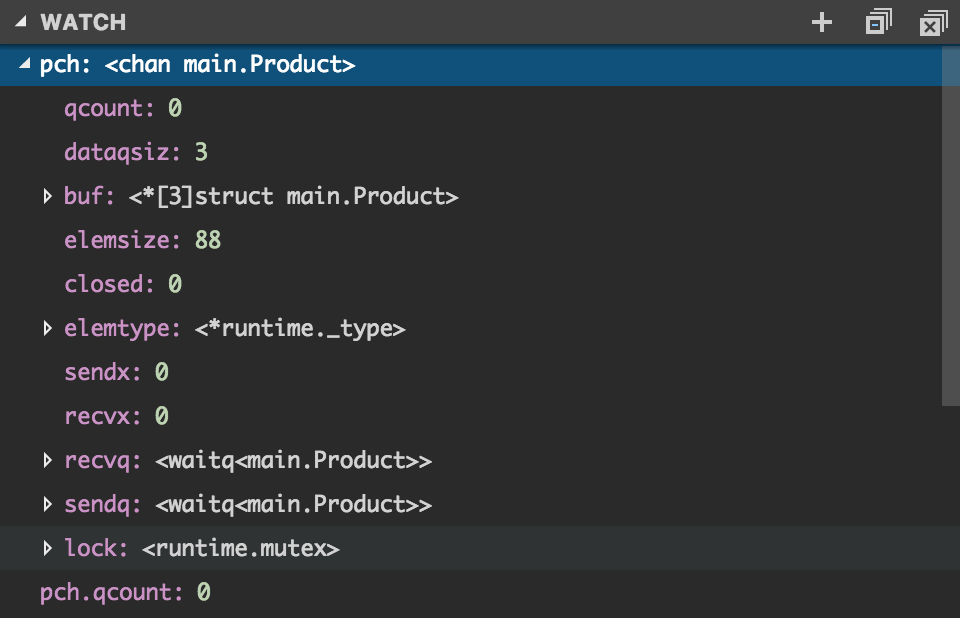
The information in a hchan struct can be broadly grouped as:
- Type information
- Buffers & queues
- Counters
- Locks & flags
Let's look at each of them in detail:
#Type information
-
elemsize
Represents the size of a single element in memory in bytes. For eg, our
Productstruct takes 88 bytes (stringtakes 16 bytes,Reviewtakes 24 bytes) in the stack. Typeinttakes 8 bytes. -
elemtype
Used when messages are copied over from one goroutine to the other. It has a bunch of fields which provide type and size information for the type of values the channel can hold. There is a bit of overlap with
elemsize.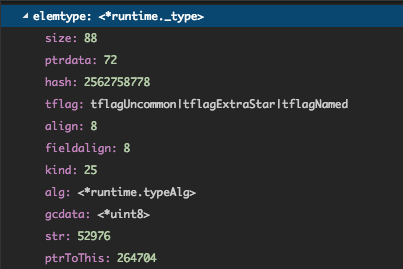
#Buffers & queues
#Buffers
-
buf
This is a circular queue. With a buffered channel of size 3,
ch := make(chan Product, 3), buf will look as follows:
Essentially
make(chan Product, 1) != make(chan Product), because when channel size is defined a circular queue implementation is used internally to hold the elements of a channel.
#Queues
-
recvq & sendq
Before we deep dive into these two fields, let's talk about
sudogstruct:
sudogrepresents a goroutine.recvq&sendqhold the information on the goroutines which are currently blocking on the channel while receiving and sending respectively. They are pointers tosudog.Taking
recvqas an example:
Image credits: Ankur Anand
sudogis designed as a doubly linked list. It has pointers to theprevandnextgoroutines which are blocking on the channel. It also contains an unsafe pointer toelem, the element which the goroutine is currently blocking on.As and when the channel is ready, the next goroutine to run is picked from the
recvqandsendqby the Go's scheduler.
#Counters
-
dataqsiz
This represents the entire buffer size of the channel, as specified by the user. Essentially, the queue capacity.
-
qcount
This represents the number of slots in the circular queue currently filled up.
-
sendx & recvx
These are indices on the circular queue,
bufto figure out where to next dequeue from (recvx) or enqueue to (sendx).Let's look at an alternative representation of the buffered channel and let's go through a few scenarios to understand the behavior of
sendxandrecvx.

Image credits: Kavya Joshi
When the channels is empty:

Image credits: Kavya Joshi
After an enqueue happens:
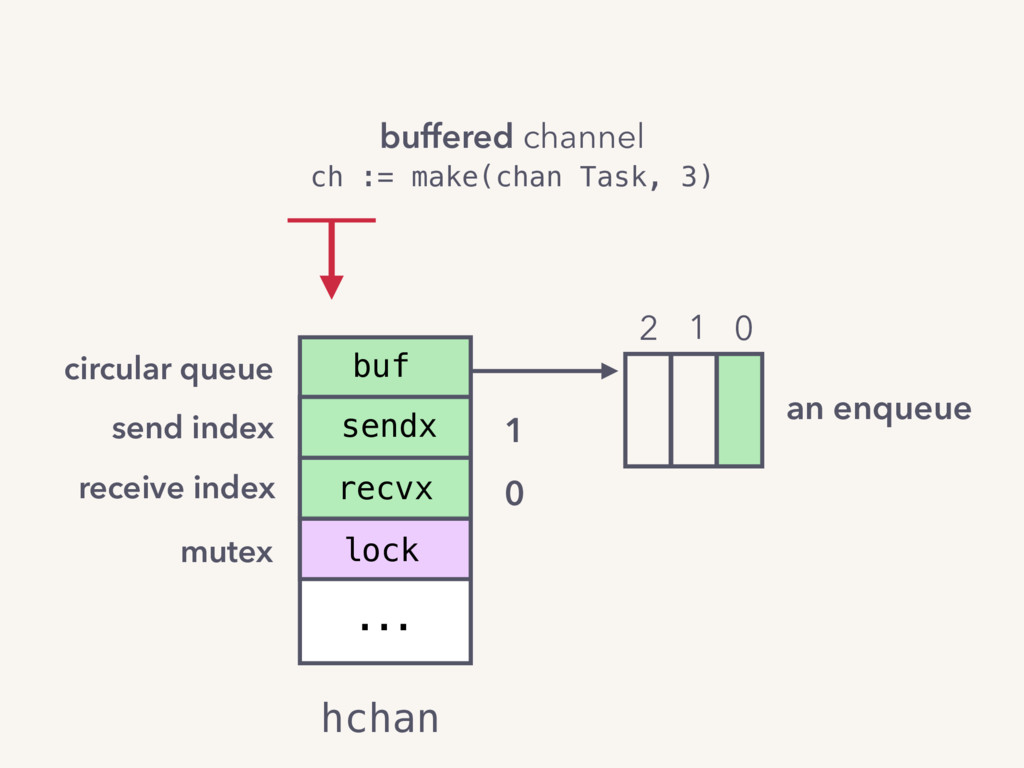
Image credits: Kavya Joshi
After the channel becomes full, note the dataqsiz & qcount become equal. All sends to this channel will block at this point.
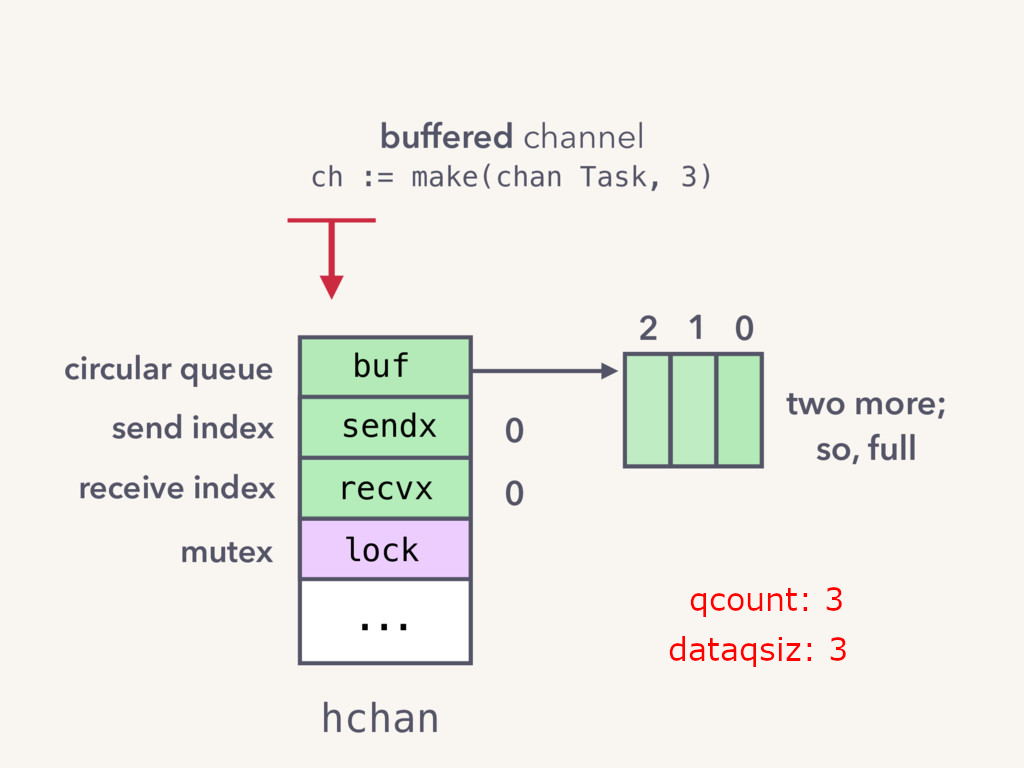
Image credits: Kavya Joshi
Let's dequeue one element:
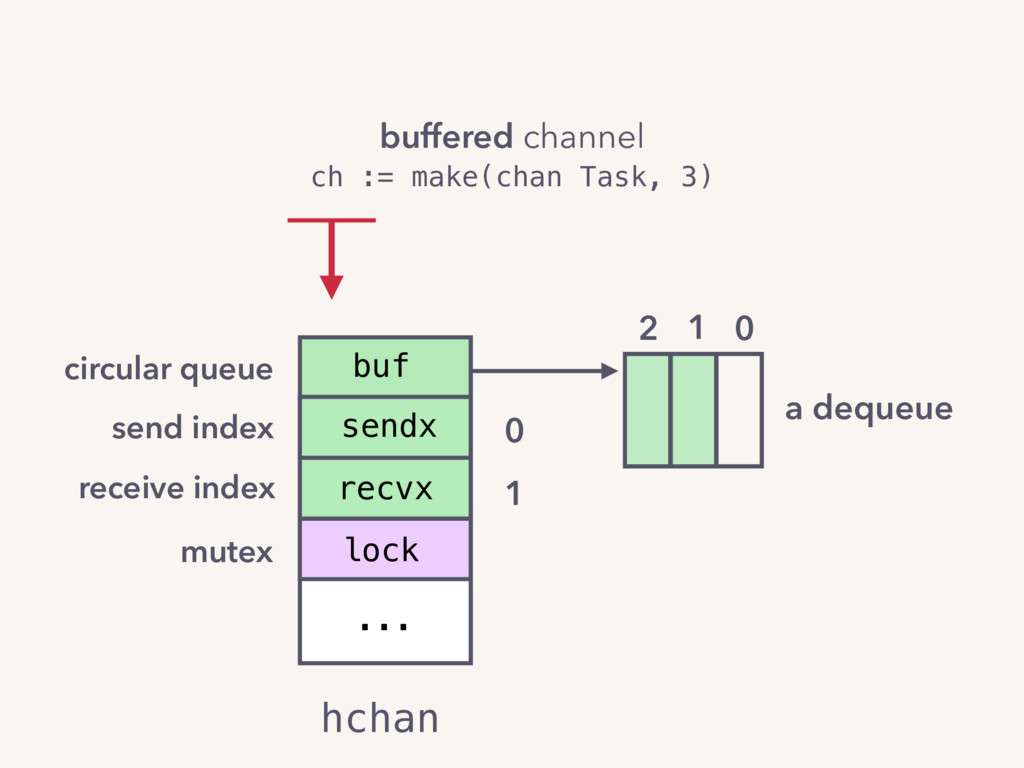
Image credits: Kavya Joshi
#Flags & locks
-
closed
This is a flag which shows whether the channel is currently closed or not. A channel can be closed by any of the goroutines which have access to the channel.
-
lock
This is a mutex which controls access to the channels. Channels are goroutine safe due to the use of this lock. It controls receives and sends to the channel, ensuring no race condition happens.
This was all you need to know to under the following demo.
#Runtime execution & demo
Please watch the following video to catch channels live in action.
#Summarizing channels
-
FIFO (first-in, first-out) - recvq/sendq
-
Do not communicate by sharing memory; instead, share memory by communicating.1
-
ThreadGoroutine safe -
First-class citizens!
#References
- Kavya Joshi's GopherCon 2017 talk on Understanding Channels
- Ankur Anand's post on Diving deep into Golang Channels
- Gaurav Agarwal's talk on Go concurrency constructs
- Using delve debugger along with Visual Studio code
Related Posts
Latest Posts
- A case for explicit mutabilityFar more programming languages promote implicit mutability as a feature (through assignment, of course) than necessary. For eg, let's take…Read More →
- An investigative walk-through of Go's channelsThis is a summary of a [talk][gopherconvietnam] I gave during Gophercon Vietnam & Gophercon India. If you have seen this talk already, you…Read More →
- Bash - n things you didn't know - Part IThis is a post I have been meaning to write for a long time now and have been procrastinating on it. These are quirks, lessons, learnings…Read More →
- Starting a new chapter...About a week back was my last day at Tarka Labs. So many people have asked me why I have left a wonderful organization, this post is to…Read More →
- There once lived a prince...There once lived a prince. He was born in fair riches, surrounded by servants and all the luxuries he could ask for. The prince, growing up…Read More →
- Setting up Flutter - Google's cross-platform native app development frameworkSince you are reading this post, I am guessing, you are probably familiar with [Flutter][fluttersite]. If not, Flutter is Google’s mobile…Read More →